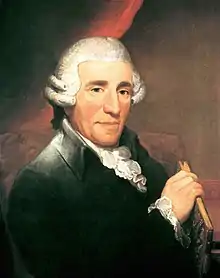Symphony No. 30 (Haydn)
The Symphony No. 30 in C major, Hoboken I/30, is a symphony by Joseph Haydn composed in 1765, at the age of 33. It is nicknamed the Alleluia Symphony because of Haydn's use of a Gregorian Alleluia chant in the opening movement.

Description
The Alleluia chant of the first movement has been confused with the principal melodic line in the finale of Mozart's Symphony No. 41 in C major.[1] Mozart did use this Alleluia chant melody for his Alleluia Canon, K. 553, written shortly after he completed his C major symphony.[2]

The work is scored for flute, two oboes, bassoon, two horns, trumpets, timpani,[3] and strings with continuo. The use of timpani in this symphony remains an unresolved matter. In his cycle, for example, Antal Dorati omits them.[4] Several more recent performances, however, have included timpani.
The work is in three movements:
The Alleluia motif dominates the first movement. It is the first theme; the second theme is also derived from it and it is also included in the closing material of the exposition. In the development, after the first theme is restated, the first three notes of the motif (do-re-mi) are repeated seven times at different pitch levels against sixteenth-note accompaniment.[5]
The second movement contains numerous solo concertante passages for the flute.[6] The rare choice of the dominant key for a second movement (subdominant was more common in Haydn) was likely because G major was a favorable key for the flute.[6]
Mark Ferraguto has discussed Haydn's deliberate use of spare instrumental scoring and minimal melodic material in the trio of the symphony.[7]
See also
References
- Peter Brown, "Eighteenth-Century Traditions and Mozart's "Jupiter" Symphony K.551" The Journal of Musicology 20 2 (2003): 187, footnote 65.
- HC Robbins Landon, Haydn: Chronicle and Works, 5 vols, (Bloomington and London: Indiana University Press, 1976-) v. 1, Haydn: the Early Years, 1732-1765
- H. C. Robbins Landon, The Symphonies of Joseph Haydn. London: Universal Edition & Rockliff (1955): 661. "Pts. for 2 clarini (trpts.) and timp. possibly authentic (as yet no copies of these pts. have been found."
- Hodgson (1976): 58, footnote.
- Brown, A. Peter, The Symphonic Repertoire (Volume 2). Indiana University Press (ISBN 025333487X), pp. 96 (2002).
- Daniel Heartz, Haydn, Mozart, and the Viennese School, 1740-1780, Norton 1995 ISBN 0-393-03712-6, ISBN 978-0-393-03712-8
- Ferraguto, Mark (March 2010). "Haydn as 'Minimalist': Rethinking Exoticism in the Trios of the 1760s and 1770s". Studia Musicologica. 51 (1/2): 61–77. JSTOR 25746240.